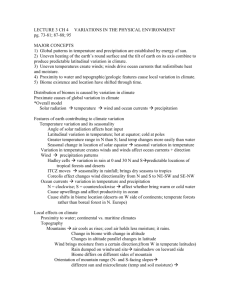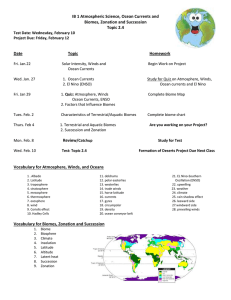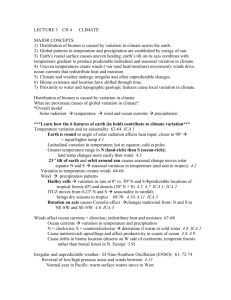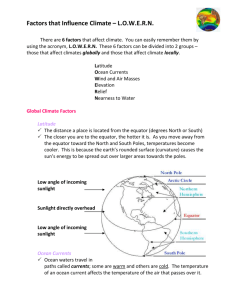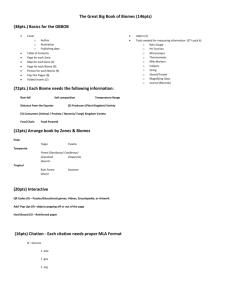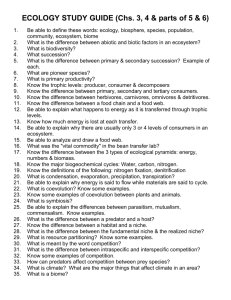03 Lecture Climate.09
advertisement
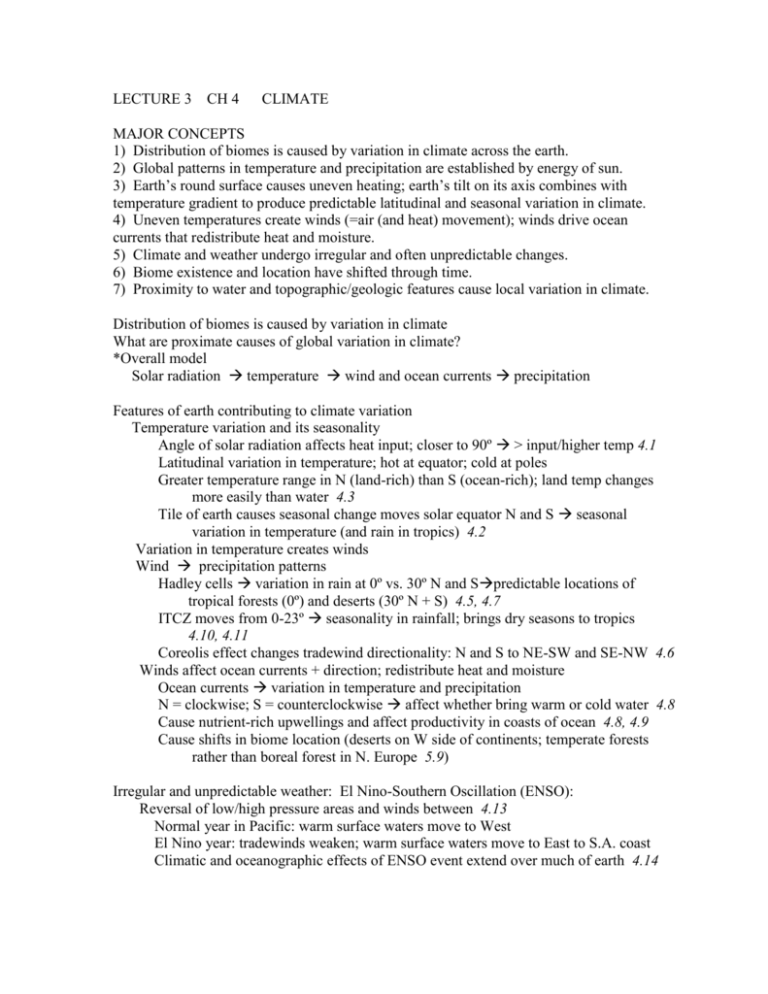
LECTURE 3 CH 4 CLIMATE MAJOR CONCEPTS 1) Distribution of biomes is caused by variation in climate across the earth. 2) Global patterns in temperature and precipitation are established by energy of sun. 3) Earth’s round surface causes uneven heating; earth’s tilt on its axis combines with temperature gradient to produce predictable latitudinal and seasonal variation in climate. 4) Uneven temperatures create winds (=air (and heat) movement); winds drive ocean currents that redistribute heat and moisture. 5) Climate and weather undergo irregular and often unpredictable changes. 6) Biome existence and location have shifted through time. 7) Proximity to water and topographic/geologic features cause local variation in climate. Distribution of biomes is caused by variation in climate What are proximate causes of global variation in climate? *Overall model Solar radiation temperature wind and ocean currents precipitation Features of earth contributing to climate variation Temperature variation and its seasonality Angle of solar radiation affects heat input; closer to 90º > input/higher temp 4.1 Latitudinal variation in temperature; hot at equator; cold at poles Greater temperature range in N (land-rich) than S (ocean-rich); land temp changes more easily than water 4.3 Tile of earth causes seasonal change moves solar equator N and S seasonal variation in temperature (and rain in tropics) 4.2 Variation in temperature creates winds Wind precipitation patterns Hadley cells variation in rain at 0º vs. 30º N and Spredictable locations of tropical forests (0º) and deserts (30º N + S) 4.5, 4.7 ITCZ moves from 0-23º seasonality in rainfall; brings dry seasons to tropics 4.10, 4.11 Coreolis effect changes tradewind directionality: N and S to NE-SW and SE-NW 4.6 Winds affect ocean currents + direction; redistribute heat and moisture Ocean currents variation in temperature and precipitation N = clockwise; S = counterclockwise affect whether bring warm or cold water 4.8 Cause nutrient-rich upwellings and affect productivity in coasts of ocean 4.8, 4.9 Cause shifts in biome location (deserts on W side of continents; temperate forests rather than boreal forest in N. Europe 5.9) Irregular and unpredictable weather: El Nino-Southern Oscillation (ENSO): Reversal of low/high pressure areas and winds between 4.13 Normal year in Pacific: warm surface waters move to West El Nino year: tradewinds weaken; warm surface waters move to East to S.A. coast Climatic and oceanographic effects of ENSO event extend over much of earth 4.14 Causes of long-term temporal changes in biome distributions Past: Continental drift; continents at different latitudes 21.4 Mountain building rain shadows arisecreate new biomes (e.g. prairie)(see below) Milankovitch cycles bring changes in earth’s orbit, tilt, and wobble Past long-term climate change (e.g. glacial/inter-glacial cycles) Present: Elevated CO2 + greenhouse effect global warming/climate change 52-53 Human alteration in land cover; loss of forest slows recycle water locally drier Local effects on climate Proximity to water (changes temperature slowly) Continental (variable) vs. maritime (coastal) (more stable) climates Topography Mountains Change in temperature and biome with change in altitude 4.20 Changes in biomes with altitude parallel changes in latitude Mountainsair cools as rises; cool air holds less moisturerains. 4.16, 4.17, 4.18 Wind brings moisture from a certain direction; (from W in temperate latitudes) Rain dumped on windward site rain shadow on leeward side Biome differs on different sides of mountain Orientation of land (N- and S-facing slopes) direct sun on S higher temp and lower soil moisture) drought-tolerant vegetation on s-facing slopes 4.19 Summary 1-10 Review 1-8 (not 5)
